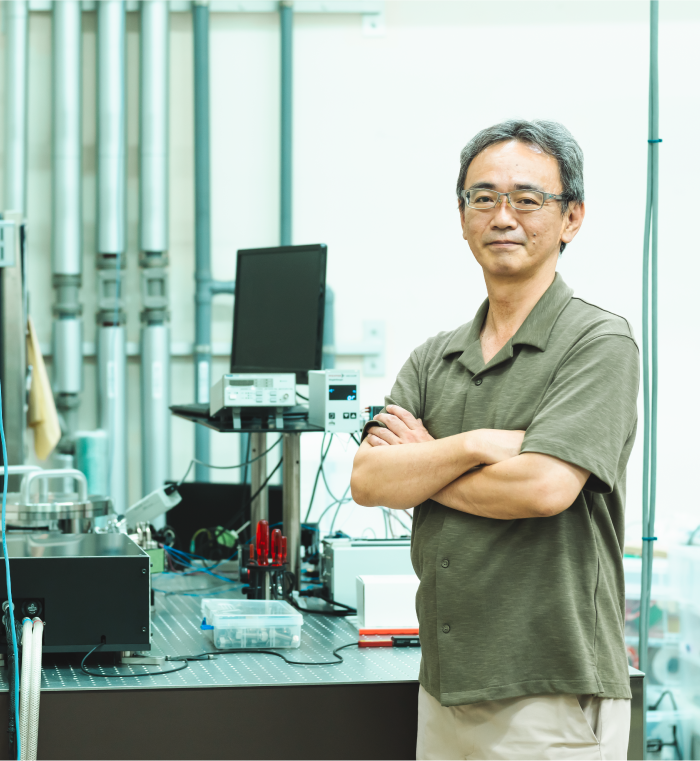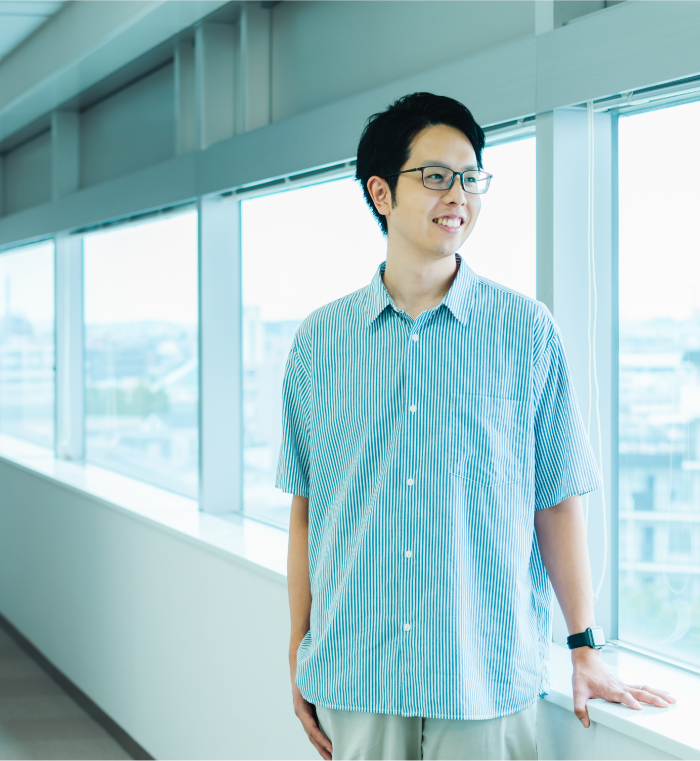
Interview
娘との国際宇宙ステーション観測で、宇宙用レーザーに
挑む覚悟が決まった
A new resolve to pursue space lasers after observing the International Space Station with my daughter
丸山 真幸
Masayuki Maruyama
技術開発部 部長代行
レーザー開発 技術責任者
Acting Head of Technical Development
Technical Lead for Laser Development

学生時代はレーザー用光学素子開発を追求し、博士号取得後は国立研究開発法人理化学研究所発のベンチャー企業メガオプトでレーザー装置開発に携わってきた丸山氏。理研時代には、旧帝大や大手光学機器メーカー・大手医療機器メーカーとともに国家プロジェクトで革新的な医療診断機器用レーザーを開発するなど、高度な技術開発を成し遂げてきました。スカパーJSATと理化学研究所の宇宙用レーザー共同開発プロジェクトに主担当として携わり、それを契機にスペースデブリ用レーザーの開発に着手。現在は株式会社Orbital Lasersのレーザー開発・技術責任者として、プロジェクトの推進や技術者のマネジメントを手掛けています。
During his student days, Mr. Maruyama focused on developing optical elements for lasers, and after obtaining his PhD, he worked at the venture company MegaOpto, which originated from the National Institutes of RIKEN, where he was involved in developing laser equipment. During his time at RIKEN, he achieved advanced technological developments, such as collaborating with prestigious universities, major optical equipment manufacturers, and leading medical device companies to develop innovative laser systems for medical diagnostic equipment as part of national projects. He later became the main person in charge of a joint development project between SKY Perfect JSAT and RIKEN to develop space lasers, which led him to begin working on lasers for space debris removal. He is currently leading laser development and technical management at Orbital Lasers Inc., where he is responsible for advancing projects and managing engineers.

Q1. 入社以前の経歴は?
Q1. What is your background prior to joining Orbital Lasers?
固体レーザー・波長変換の研究を続けて20年以上。
国立研究開発法人理化学研究所での経験をもとに、宇宙分野へ
Over 20 years of research in solid-state lasers and wavelength conversion, transitioning to the space field based on experience at RIKEN.
学生時代は応用物理を専攻し、光通信に関係する研究室に所属していました。自然科学研究機構分子科学研究所や国立研究開発法人物質・材料研究機構でレーザー波長変換素子開発を行い、世界最高効率を達成するなどして二つの学会賞を受賞するなど、充実した研究生活を送っていました。博士号を取得後、新卒でレーザー装置開発を行う理研ベンチャー企業に就職。当時、博士号を取得した院生がベンチャーに勤めるのは異例でしたが、この時に開発業務だけでなく、技術営業として客先に出向いたり、出荷準備に奔走したりと、現場経験もたくさんさせていただきました。今振り返ると「経験しておいて、よかった」と感じますね。その後、理研に移り、「医療診断機器用レーザー」をはじめ、世界初のレーザー技術を使用した「南極氷床コア高精度サンプリング装置」の開発や、「生分解性繊維強化樹脂のレーザー非破壊可視化技術開発」などに携わりました。ベンチャーや理研での経験は、技術者・研究者として大きく能力を伸ばせた時期だと自負しています。
During my student days, I majored in applied physics and was part of a research lab focused on optical communications. I developed laser wavelength conversion devices at the National Institute for Molecular Science and the National Institute for Materials Science, achieving the world's highest efficiency and receiving two academic awards for my work. After obtaining my PhD, I joined a venture company originating from RIKEN that developed laser equipment, which was quite unusual at the time for someone with a PhD. In addition to development work, I also gained hands-on experience in technical sales and shipment preparations, which in hindsight, I’m glad I experienced. Later, I moved to RIKEN, where I worked on groundbreaking projects such as lasers for medical diagnostic equipment, the world’s first laser-based precision sampling device for Antarctic ice cores, and non-destructive laser visualization technology for biodegradable fiber-reinforced plastics. My time at the venture and RIKEN helped me significantly grow as both an engineer and a researcher.
Q2. Orbital Lasers に入社したキッカケは?
Q2. What motivated you to join Orbital Lasers?
娘との国際宇宙ステーション観測で見つけた
スペースデブリで宇宙が身近に。宇宙用レーザーの開発に、技術者人生を捧げる覚悟が決まった
The space debris I discovered while observing the ISS with my daughter made space feel close, leading to my resolve to dedicate my career to developing space lasers.
理研時代に縁あって参画することになったのが、スカパーJSATとの宇宙用レーザー共同研究プロジェクトでした。参画当初は、私にとって「宇宙」はとても遠い存在でした。しかしある日、娘と自由研究のために国際宇宙ステーション観測をしていたら、不思議な光を見つけたのです。それが、スペースデブリでした。スペースデブリの存在をリアルに感じたのは、それが初めて。宇宙用レーザーの開発が、一気に身近なものに感じられた、不思議な経験でした。その瞬間に「これからは、宇宙事業に全力を注ごう」と不思議とエネルギーが湧いてきたというか、覚悟が決まったんです。
While at RIKEN, I had the opportunity to participate in a joint research project with SKY Perfect JSAT on space lasers. At that time, "space" felt very distant to me. However, one day while observing the International Space Station with my daughter for her science project, we noticed a strange light. It turned out to be space debris. That was the first time I truly felt the reality of space debris. It was a strange experience that made the development of space lasers suddenly feel very close. At that moment, I felt a surge of energy and made up my mind: "From now on, I will fully dedicate myself to the space industry."
Q3. 社内の雰囲気は?
Q3. What is the atmosphere like within the company?
知識やノウハウは惜しみなく共有し、吸収できる環境。
スペシャリストたちの融合が、新しいシナジーを創り出す
A culture where knowledge and know-how are shared freely, creating an environment of absorption and synergy among specialists.
Orbital Lasersには「宇宙」や「レーザー」を始め、さまざまな分野のスペシャリストが集っています。経験豊富ないわゆるベテラン技術者たちは、日々新しい技術や出来事への感度が高く、後進の育成にも余念がありません。一方で若手技術者たちも、スポンジのように知識やノウハウを吸収していくので、驚かされます。Orbital Lasers代表の福島も、わからないことは決してそのままにしないタイプ。代表のそんな姿勢が社内にも自然と伝播し、納得するまで話し合い、試行錯誤しながら課題解決に取り組む風土が根付いています。年齢や立場、専門分野を超えて、とことんディスカッションできるこの関係性は、私がOrbital Lasersを「いいな」「好きだな」と感じる大きな理由でもあります。
At Orbital Lasers, specialists from various fields, including "space" and "lasers," have come together. Veteran engineers, with their extensive experience, are highly receptive to new technologies and developments, and they are also keen on nurturing the next generation. Meanwhile, the younger engineers absorb knowledge and skills like sponges, which often surprises me. CEO Fukushima also never leaves any uncertainty unresolved, a trait that has naturally spread throughout the company. This has created a culture where we engage in thorough discussions and trial-and-error until we reach satisfactory solutions. This open relationship, where age, rank, or expertise don’t hinder discussions, is one of the things I really appreciate and enjoy about working at Orbital Lasers.

Q4. 現在の業務内容について
Q4. What is your current role?
高効率&高精度で注目されるレーザーを用いた「デブリ除去技術及びライダー技術」
技術責任者として開発プロジェクトを主導
Leading the development of debris removal and LiDAR technology using high-efficiency, high-precision lasers as Chief Technology Officer.
現在は、スペースデブリ除去用のレーザー開発部門を主導しています。スペースデブリ除去に取り組む企業は他にもありますが、レーザー技術を活用しているのはOrbital Lasersだけです。この技術は宇宙空間との親和性が高く、高効率かつ高精度であるため、近年注目を集めており、ライダー技術開発にもつながっています。まだ技術的な課題も多いですが、私たちOrbital Lasersは「宇宙×レーザー」の可能性を信じ、自分たちのプロダクトを宇宙空間に届けてサービスを展開することを目指しています。
Currently, I’m leading the laser development division for space debris removal. While there are other companies working on debris removal, Orbital Lasers is the only one utilizing laser technology. This technology, which is highly compatible with space, is attracting attention for its high efficiency and precision, and it is also being applied to the development of LiDAR technology. There are still many technical challenges, but at Orbital Lasers, we believe in the potential of "space × lasers," and we aim to launch our product into space to provide services.
Q5. どんな人と一緒に働きたいか?
Q5. What kind of people would you like to work with?
専門外の分野であっても、知りたい、学びたいという探究心と、
未知を理解しようとする柔軟な姿勢が、技術開発を前進させる
Curiosity to learn even in fields outside your expertise and a flexible mindset to understand the unknown are essential for advancing technology development.
私たちが取り組んでいるのは、まだ誰も成し遂げたことのない技術開発です。だからこそ「幅広い視点」と「柔軟な発想」が欠かせません。Orbital Lasersには専門分野はもちろん、専門外の領域でも主体的に学び、日々、知見を広げている技術者が揃っています。そうした努力もあって、数手先を読んで解決策を導き出す力や、他者の意見を高い解像度で理解する力が養われているのだと感じます。これから加わるメンバーには、既存の価値観にとらわれずに、未知のものを理解しようとする柔軟な姿勢を大切にしてほしいです。そして、私たちとともに、世の中をあっと驚かせるような成果を生み出すことができたなら、嬉しいですね。
We are working on technology that no one has achieved yet, which is why broad perspectives and flexible thinking are essential. At Orbital Lasers, we have engineers who not only focus on their areas of expertise but also actively learn about other fields, expanding their knowledge every day. This effort cultivates the ability to think several steps ahead and derive solutions, as well as to understand others’ opinions with high clarity. I hope that new members will maintain a flexible attitude, eager to understand the unknown without being constrained by existing values. It would be fantastic if, together, we could achieve results that amaze the world.





